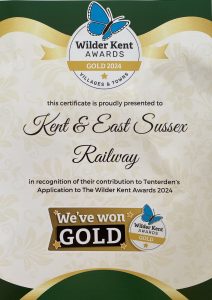The Kent & East Sussex Railway has been recognised for its contribution to Tenterden Town’s Gold Wilder Kent Award 2024 with a certificate presented at a reception, hosted by the Mayor of Tenterden, on Wednesday 25 September 2024.
 The event, in St Mildred’s Church, was attended by representatives from the various organisations who had played a part in the town’s award submission and also in the recently adopted Tenterden Town Neighbourhood Plan.
The event, in St Mildred’s Church, was attended by representatives from the various organisations who had played a part in the town’s award submission and also in the recently adopted Tenterden Town Neighbourhood Plan.
The K&ESR Sustainability Group collaborated with Tenterden Wildlife and Tenterden Town Council to provide detailed information about the wildlife and habitats that it cares for. This comprised data from its two-year long ecological survey of birds and bees found along the line plus details of the ongoing work being undertaken to support nature recovery across the estate. This includes the planting of more than 3,000 in recent years.
The railway forms a unique and special nature corridor along its 10.5 miles of track, plus the areas around its stations and yards. These play host to a rich range of wildlife and special habitats which support them. Some 89 different species of birds and 15 bumblebees were identified in the ecological survey. Seventeen of the birds appear on the Red List of endangered species and 22 on the Amber List, including Turtle Doves and Nightingales, plus two rare species of bumblebee: the Light Ruderal and the Black Form Ruderal. Well over 70 flowers grow along the line and an abundance of slow worms have been identified, together with smaller number of grass snakes, in the latest surveys.
“We are delighted and honoured to have been able to contribute to Tenterden Town’s Gold Wilder Kent Award,” said Keith Barron, Lead on Biodiversity & Habitats for the K&ESR’s Sustainability Group. “The railway is custodian to a remarkable – if accidental – nature reserve, so we have a unique opportunity to protect and regenerate these habitats, helping to link up green corridors that benefit nature, our neighbours and our visitors.”


